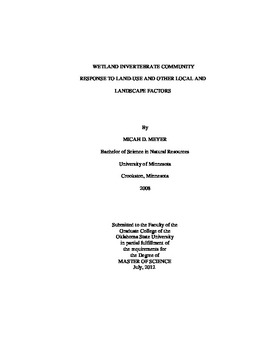| dc.description.abstract | The objectives of this study were to determine the influence of land-use and other local and landscape factors on wetland invertebrate diversity, biomass, and taxa composition within depressional wetlands of Oklahoma. Fifty-eight wetlands in north central Oklahoma were sampled for invertebrates during 2009 and 2010. All wetlands were closed depressional, palustrine wetlands. Wetlands were located within annually tilled cropland, improved pastureland, or native rangeland. To determine the influence of land-use on the invertebrate community means were compared for invertebrate diversity, biomass of taxa and functional feeding groups among the land-use practices. Differences in taxa composition between land-use practices were also assessed. To determine the influence of local and landscape factors, linear regression and ordination was used to determine the variables explaining the most variation in invertebrate diversity, the biomass of the most common taxa, and taxa composition. Local factors included vegetation complexity and water quality, while landscape factors included land-use practices and wetland area within 1 and 2 km of study wetlands. Land-use influenced nine invertebrate taxa, three functional feeding groups, as well as invertebrate taxa composition. The majority of the taxa did not significantly respond to land-use practices. However, differences in plant cover, vegetation complexity, and water quality among the land-use practices suggest some degradation of wetlands caused by land-use. High variability among sites may have prevented finding more significant results. Numerous local and landscape factors did significantly explain variation in invertebrate taxa biomass as well as taxa composition. Overall, 24 taxa had the most variation explained with local factors, while seven taxa had the most variation explained by landscape factors. The most variation in taxa composition was explained by local factors. Dominant local factors were vegetation complexity, plant cover, and water depth, while wetland density, hydroperiod diversity, and land-use practices were important landscape factors. The results indicate that management and conservation efforts should consider habitat quality within the wetland, but also wetland habitat availability within the landscape. | |
